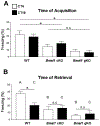Modulation of learning and memory by the genetic disruption of circadian oscillator populations
- PMID: 29944860
- PMCID: PMC7875063
- DOI: 10.1016/j.physbeh.2018.06.035
Modulation of learning and memory by the genetic disruption of circadian oscillator populations
Abstract
While a rich literature has documented that the efficiency of learning and memory varies across circadian time, a close survey of that literature reveals extensive heterogeneity in the time of day (TOD) when peak cognitive performance occurs. Moreover, most previous experiments in rodents have not focused on the question of discriminating which memory processes (e.g., working memory, memory acquisition, or retrieval) are modulated by the TOD. Here, we use assays of contextual fear conditioning and spontaneous alternation in WT (C57Bl/6 J) mice to survey circadian modulation of hippocampal-dependent memory at multiple timescales - including working memory (seconds to a few minutes), intermediate-term memory (a delay of thirty minutes), and acquisition and retrieval of long-term memory (a delay of two days). Further, in order to test the relative contributions of circadian timing mechanisms to the modulation of memory, a parallel set of studies were performed in mice lacking clock timing mechanisms. These transgenic mice lacked the essential circadian gene Bmal1, either globally (Bmal1 null) or locally (floxed Bmal1 mice, which lack Bmal1 in excitatory forebrain neurons, e.g. cortical and hippocampal neurons). Here, we show that in WT mice, retrieval (but not working memory, intermediate-term memory, or acquisition of long-term memory) is modulated by TOD. However, transgenic mouse models lacking Bmal1 - both globally, and only in forebrain excitatory neurons - show deficits regardless of the memory process tested (and lack circadian modulation of retrieval). These results provide new clarity regarding the impact of the TOD on hippocampal-dependent memory and support the key role of hippocampal and cortical circadian oscillations in circadian gating of cognition.
Keywords: Bmal1; Circadian; Hippocampus; Learning; Memory.
Copyright © 2018. Published by Elsevier Inc.
Conflict of interest statement
Declarations of interest
None.
Figures




Similar articles
-
Modulation of learning and memory by the targeted deletion of the circadian clock gene Bmal1 in forebrain circuits.Behav Brain Res. 2016 Jul 15;308:222-35. doi: 10.1016/j.bbr.2016.04.027. Epub 2016 May 4. Behav Brain Res. 2016. PMID: 27091299 Free PMC article.
-
Impact of Targeted Deletion of the Circadian Clock Gene Bmal1 in Excitatory Forebrain Neurons on Adult Neurogenesis and Olfactory Function.Int J Mol Sci. 2020 Feb 19;21(4):1394. doi: 10.3390/ijms21041394. Int J Mol Sci. 2020. PMID: 32092990 Free PMC article.
-
Hippocampal clock regulates memory retrieval via Dopamine and PKA-induced GluA1 phosphorylation.Nat Commun. 2019 Dec 18;10(1):5766. doi: 10.1038/s41467-019-13554-y. Nat Commun. 2019. PMID: 31852900 Free PMC article.
-
A time to remember: the role of circadian clocks in learning and memory.Behav Neurosci. 2014 Jun;128(3):283-303. doi: 10.1037/a0035963. Epub 2014 Apr 7. Behav Neurosci. 2014. PMID: 24708297 Free PMC article. Review.
-
Circadian rhythms and memory formation.Nat Rev Neurosci. 2010 Aug;11(8):577-88. doi: 10.1038/nrn2881. Nat Rev Neurosci. 2010. PMID: 20648063 Free PMC article. Review.
Cited by
-
Bmal1 in the striatum influences alcohol intake in a sexually dimorphic manner.Commun Biol. 2021 Oct 26;4(1):1227. doi: 10.1038/s42003-021-02715-9. Commun Biol. 2021. PMID: 34702951 Free PMC article.
-
Circadian disruption of memory consolidation in Drosophila.Front Syst Neurosci. 2023 Mar 22;17:1129152. doi: 10.3389/fnsys.2023.1129152. eCollection 2023. Front Syst Neurosci. 2023. PMID: 37034015 Free PMC article.
-
Spatio-temporal heterogeneity in hippocampal metabolism in control and epilepsy conditions.Proc Natl Acad Sci U S A. 2021 Mar 16;118(11):e2013972118. doi: 10.1073/pnas.2013972118. Proc Natl Acad Sci U S A. 2021. PMID: 33692123 Free PMC article.
-
Neural function of Bmal1: an overview.Cell Biosci. 2023 Jan 2;13(1):1. doi: 10.1186/s13578-022-00947-8. Cell Biosci. 2023. PMID: 36593479 Free PMC article. Review.
-
Circadian regulation of membrane physiology in neural oscillators throughout the brain.Eur J Neurosci. 2020 Jan;51(1):109-138. doi: 10.1111/ejn.14343. Epub 2019 Jan 29. Eur J Neurosci. 2020. PMID: 30633846 Free PMC article. Review.
References
-
- Monk TH, Buysse DJ, Reynolds CF, Berga SL, Jarrett DB, Begley AE, Kupfer DJ, Circadian rhythms in human performance and mood under constant conditions, J. Sleep Res 6 (1997) 9–18. - PubMed
Publication types
MeSH terms
Substances
Grants and funding
LinkOut - more resources
Full Text Sources
Other Literature Sources
Molecular Biology Databases

